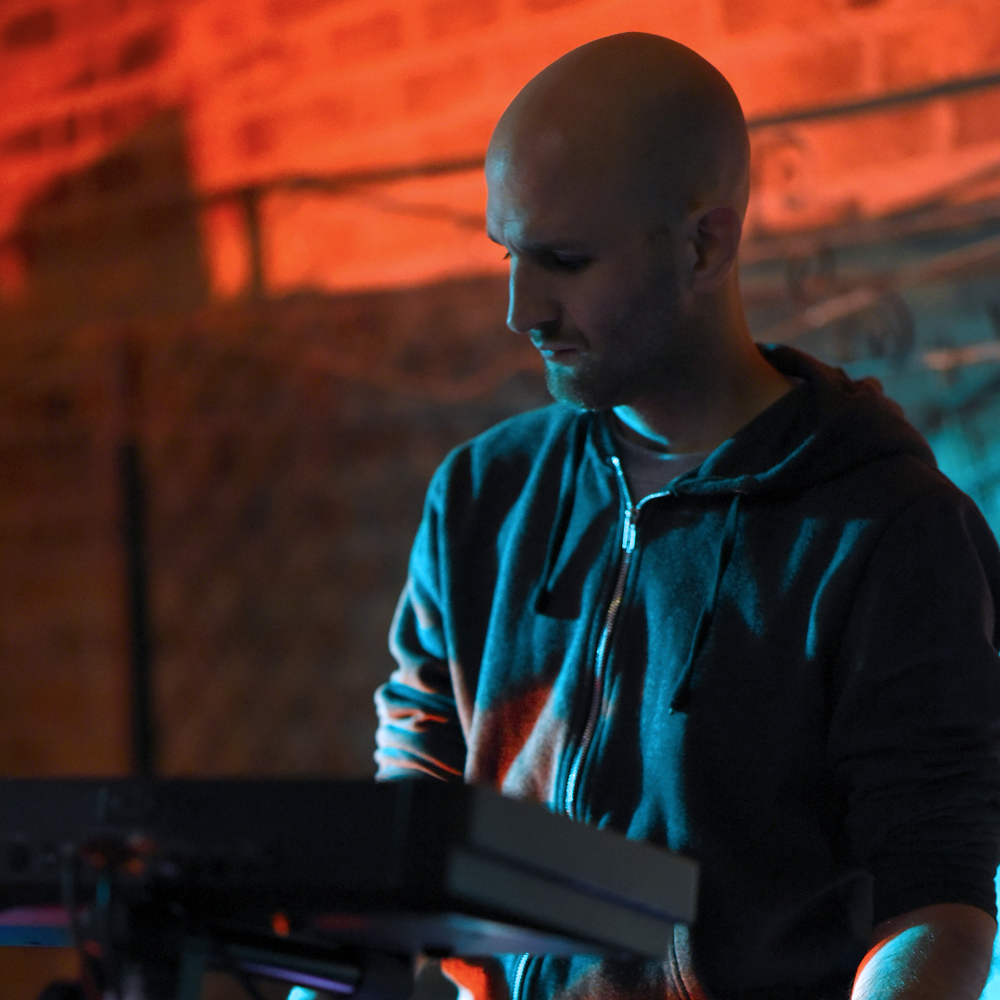Fantastic (free) synths and how to use them: DiscoDSP OB-Xd
We open the hood on a powerful (and free!) Oberheim emulation and dive into the world of analogue modelling
PLUGIN WEEK 2023: In the first edition of this series, we outlined the core principles of subtractive synthesis with the aid of TAL’s NoiseMaker, a versatile, and very capable, free software synthesiser.
With the principles of subtractive synthesis in mind, in this tutorial we’ll delve into the world of analogue modelling with the aid of another fantastic (and free) software synthesiser: DiscoDSP’s OB-Xd.
The OB-Xd is based on the Oberheim OB-X, a true icon of late 1970s and early 1980s synthesis. The OB-X came in a few different iterations over the years, and depending on the model was capable of 4, 6 or 8 voice polyphony (a significant number of voices for the time).
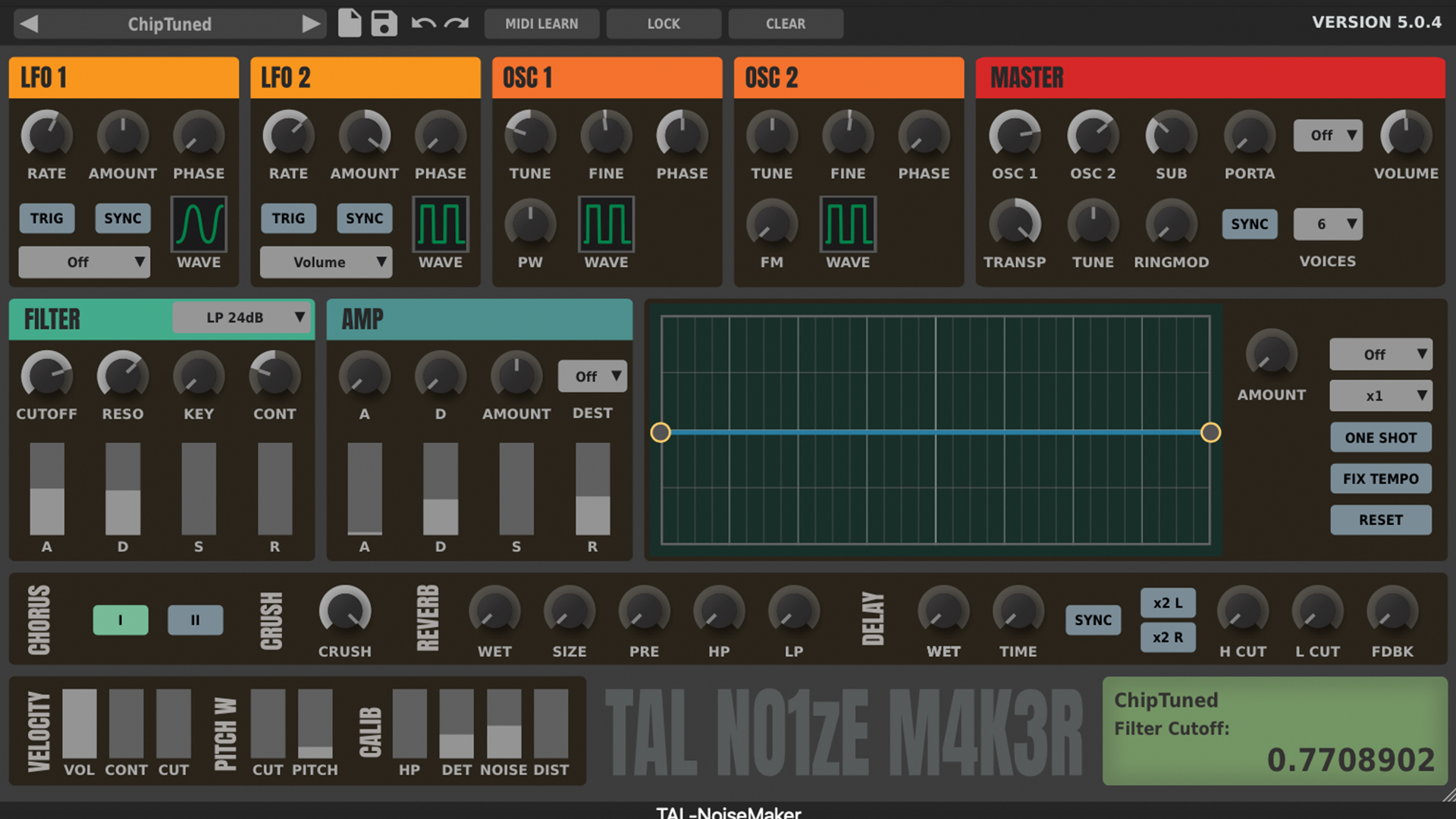
The Oberheim brand isn’t as ubiquitous as other synthesiser manufacturers (such as Roland, Korg and Yamaha) and so you can be forgiven for not having heard of them. However, whilst you might not have heard of Oberheim, you’ve almost definitely heard an Oberheim! The list of artists who’ve used the Oberheim OB-X is extensive and includes household names such as Madonna, Queen, and Prince, but perhaps its most famous moment in the limelight is as the synthesiser used on the iconic intro of Van Halen’s Jump.
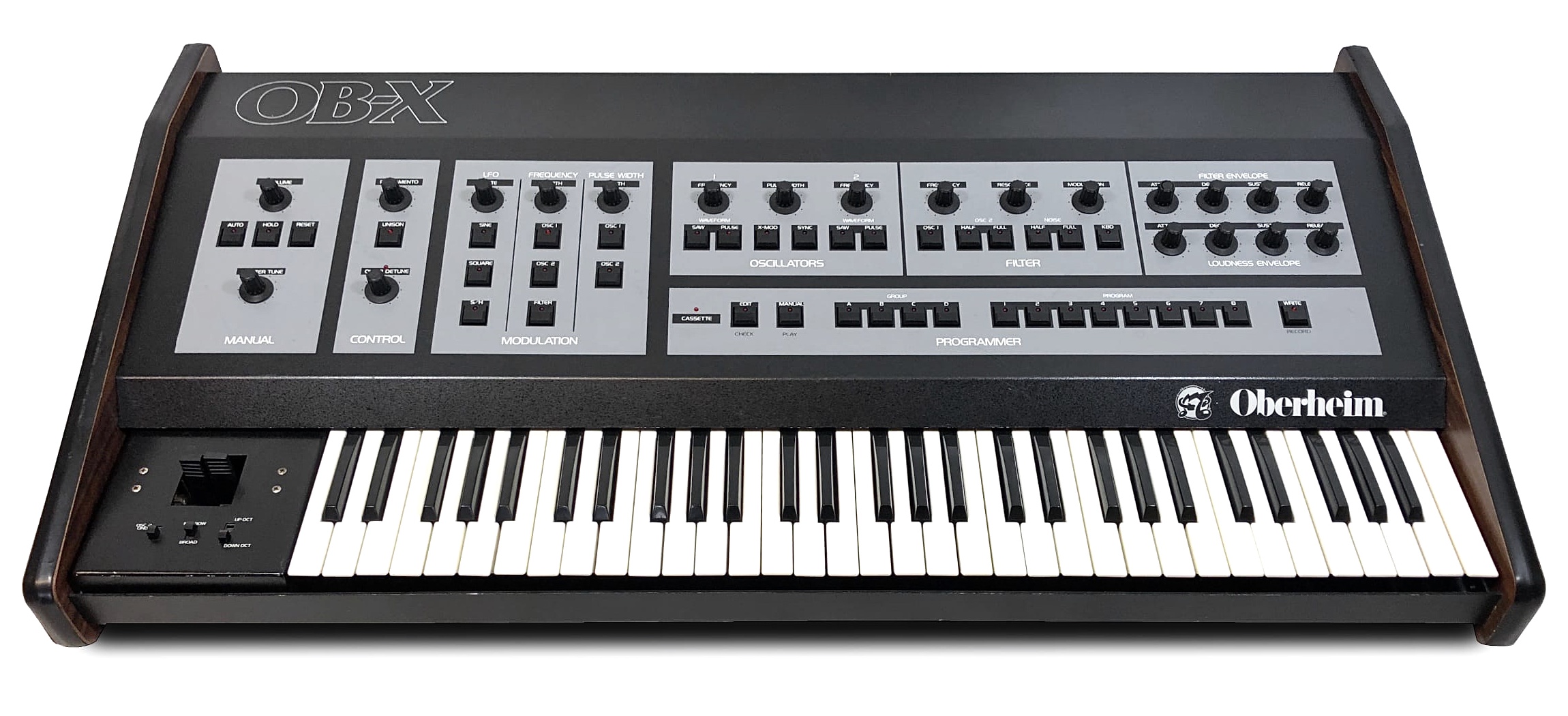
Perfectly imperfect
A criticism often levelled at digital and software synthesisers is that their digital precision strips them of character and warmth. This is a debate that began with the advent of digital synthesisers in the mid-1980s, and continues to this day with software synthesisers.
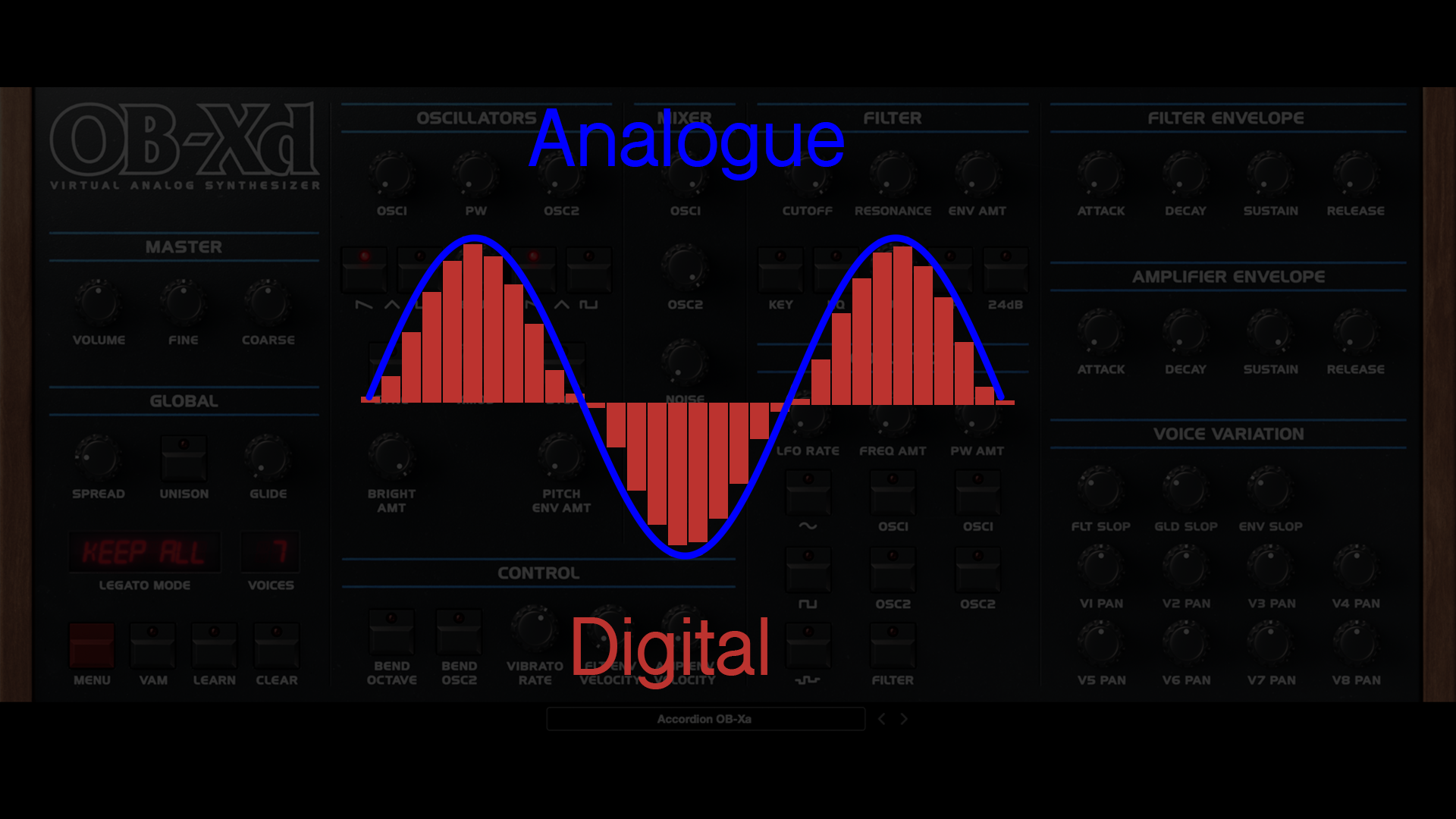
Analogue synthesisers were often far from perfect, in terms of pitch stability and linearity of adjustable parameters. Their oscillators would often contain microtonal quirks and disparities leading to tuning anomalies. Their filters, envelopes and LFOs could all contain unique nuances which were determined by the individual quality of each component.
They could also be fickle and troublesome if they got too warm (or weren’t warm enough). For all intents and purposes, they were more akin to acoustic instruments in terms of delicacy, care, maintenance, servicing, condition, operating scenarios, imperfections, and so on.
Want all the hottest music and gear news, reviews, deals, features and more, direct to your inbox? Sign up here.
Whilst the digital synthesiser boom sought to remedy these logistical problems, many believed it came at the cost of sonic character, warmth and musicality. Today however, digital technology has come a long way and is now able to bridge the gap (in many ways) between the analogue and digital tonal palette.
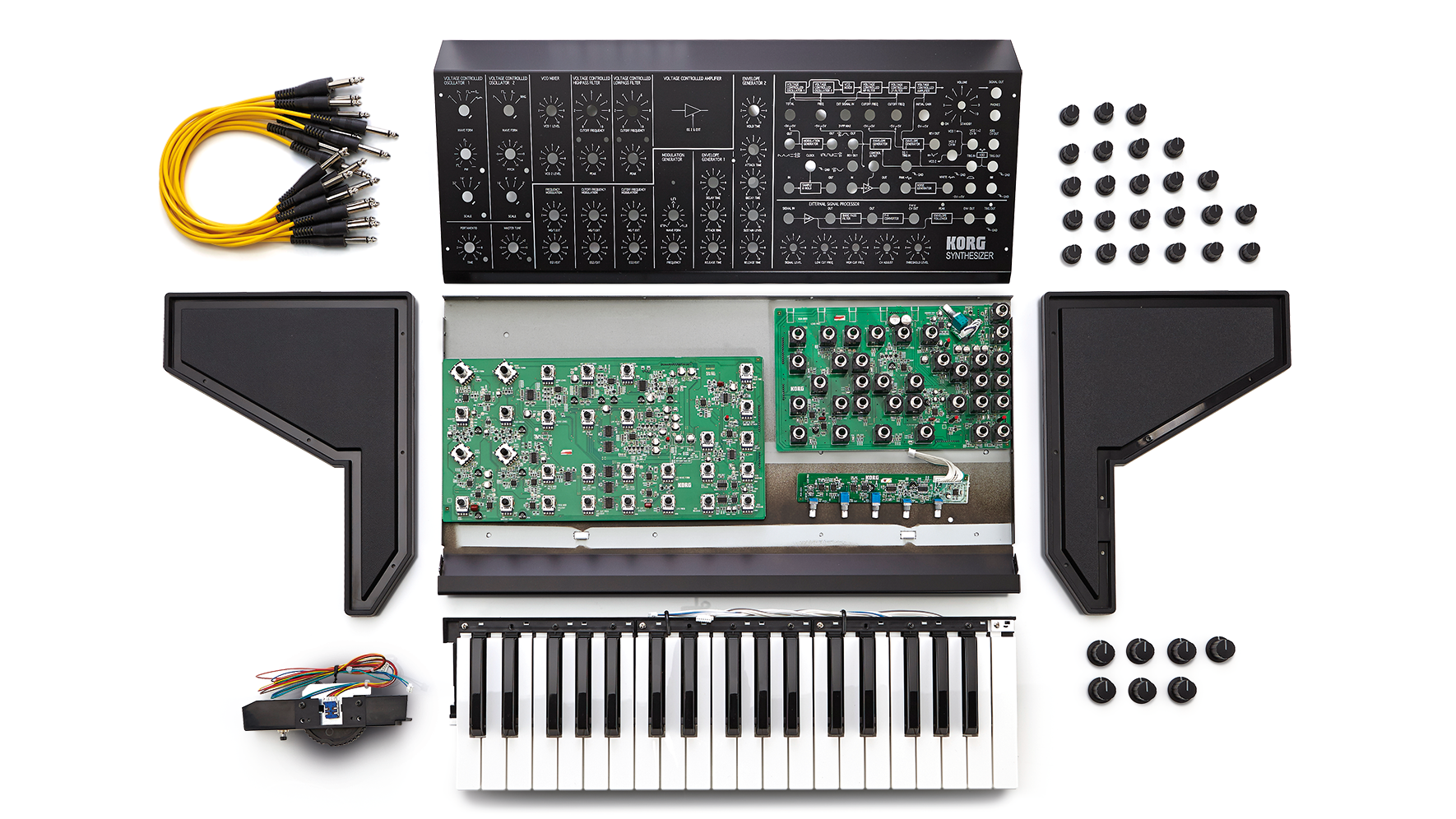
This is typically achieved by sophisticated, subtle randomisation-algorithms which might focus on one or multiple parameters of a digital/software-synth (as well as sometimes emulating the tonal “colouration” of the audio-signal path and output-amps of the synthesiser being emulated). Usually such software synths command a substantial price tag, however the wonderful people at DiscoDSP have developed a very faithful OB-X recreation, and it’s free!
The caveat to the freeware licence is an honesty policy which requests that you pay the $49 asking price only if you’re using the OB-Xd for commercial purposes. If you’re not commercially releasing music, but rather experimenting, learning, or jamming, DiscoDSP are happy for you to download and use this software for free.
How it works
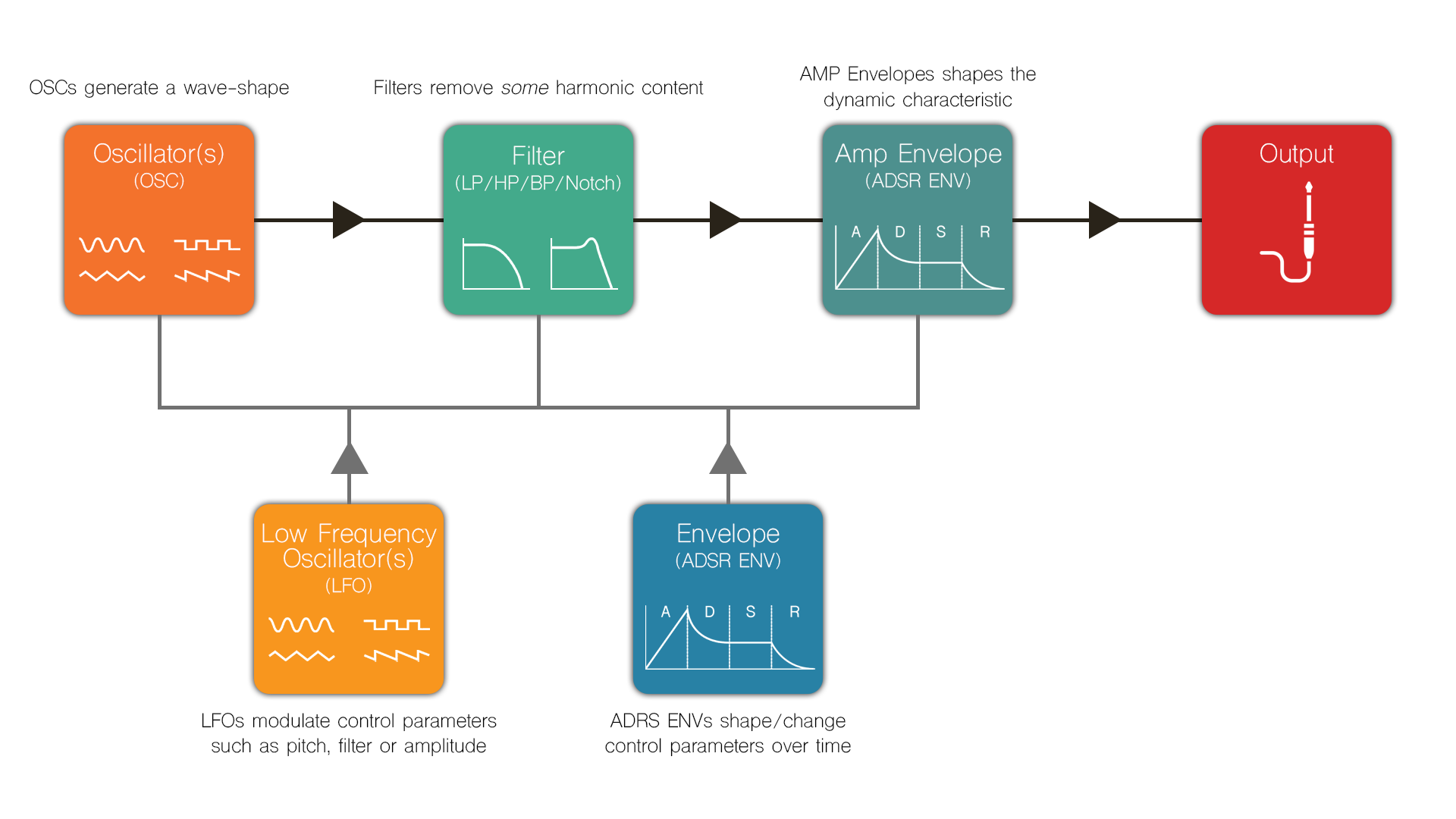
The architecture of the OB-Xd is straightforward and follows the same principles of most subtractive synthesisers; OSC>LPF>ENV with an LFO on the side, for some wobbly fun.
Broadly speaking, what sets this synthesiser apart is simply how substantial and characterful its oscillators are, along with a few distinct and interesting control parameters that we’ll get into below.
Oscillators
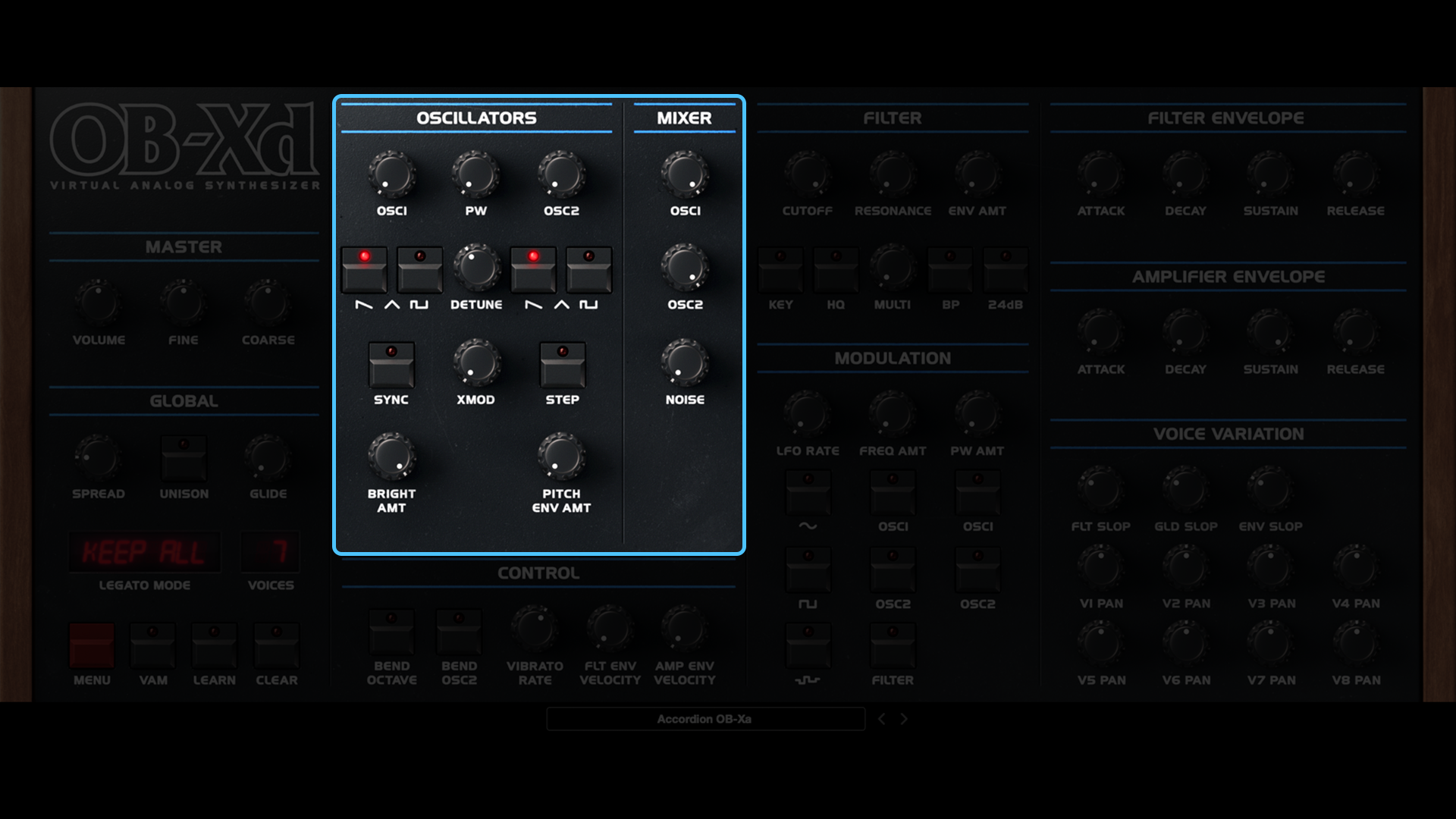
It’s arguable that a great deal of the OB-X’s tonal philosophy stems from the relationship between the two primary oscillators (as opposed to filter characteristics). With that in mind, like a bold statement of intent on the designers’ part, the dials at the very top of the OSC section (which one might intuitively assume to be volume/loudness of each OSC) are actually tuning/pitch.
This draws the user’s attention first and foremost to manipulating each oscillator’s individual fine tuning (spanning four octaves!), invoking all manner of narrow/loose unsynchronised unison, invoking thickening, chorus-like effects, tonal intervals, or even dissonant textures and soundscapes.
There are four OSC shapes: triangle, sawtooth and pulse (with adjustable pulse width - PW), and a ramped pulse-wave, which is achieved by selecting both sawtooth and pulse options combined. When neither sawtooth or pulse is selected, the OSC produces a triangle wave.
- DETUNE - Global detuning of both OSC
- XMOD (cross-modulation) - Modulates OSC1 according to (the tuning and amplitude of) OSC2 - great for chorus-like modulating effects and/or FM-style grittiness
- STEP - Switches the OSC tuning dials from continuous to stepped (exact pitches)
- SYNC - Synchronises the +/- oscillations of both OSC1 and OSC2 resulting in a narrower, more precise tone
- BRIGHT AMT - Adjusts the brightness of the upper harmonics
The MIXER section is fairly self-explanatory, providing volume controls for both OSC as well as a third, NOISE OSC.
Filter
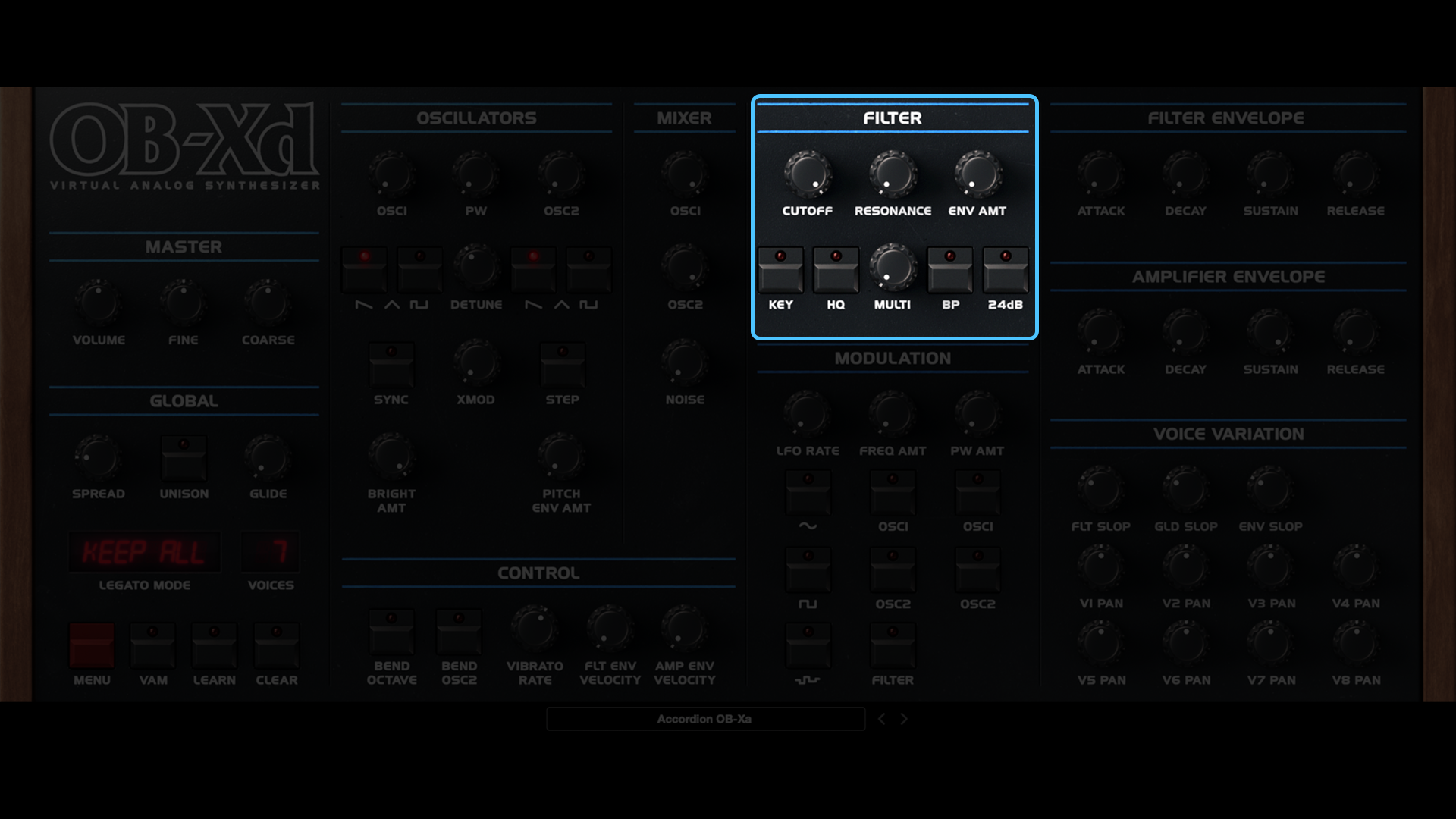
By default, the filter is a 12dB/octave low-pass-filter (LPF) with the usual controls of CUTOFF and RESONANCE. There is also:
- ENV AMT - How influential the FILTER ENVELOPE is
- KEY - Key-follow or keyboard-tracking, i.e. the filter is less intrusive on higher pitches
- HQ - Higher quality interpolation of frequencies (at the cost of CPU usage)
- MULTI - Allows you to morph the filter shape (as opposed to switch) between LPF (far left), Notch (centred), and HPF (far right)
- BP - Switches the Notch filter (when the MULTI dial is centred) to a Band-pass (not functional when 24dB is active)
- 24dB - Switches the FILTER from 12dB/Octave to 24dB/Octave
Envelopes
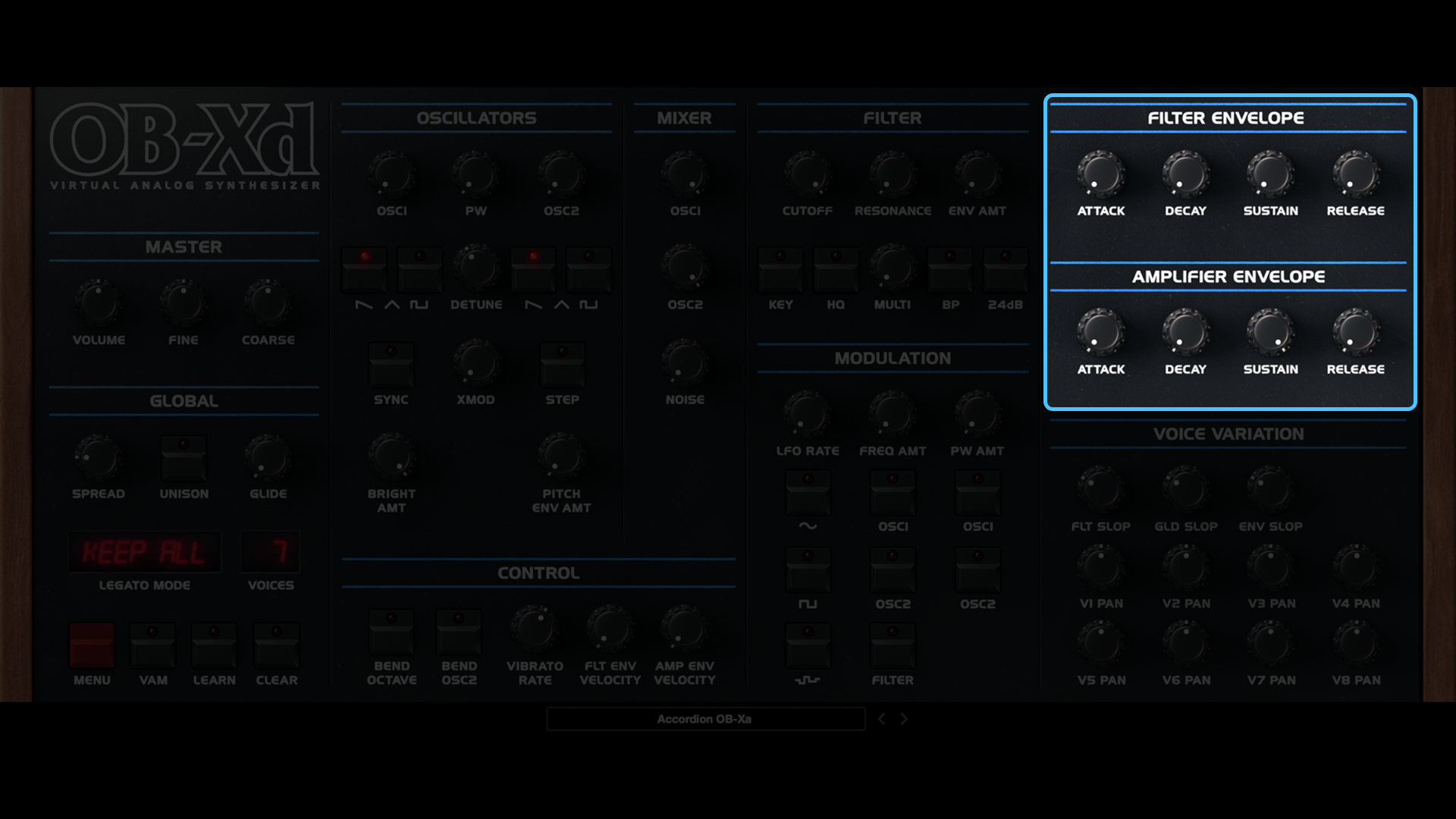
The envelope section utilises a typical ADSR envelope for both the FILTER and AMPLITUDE. These envelopes can be further manipulated by other parameters discussed later in the article.
Now let’s dig into some more unique, interesting and unusual characteristics of the OB-Xd.
Control
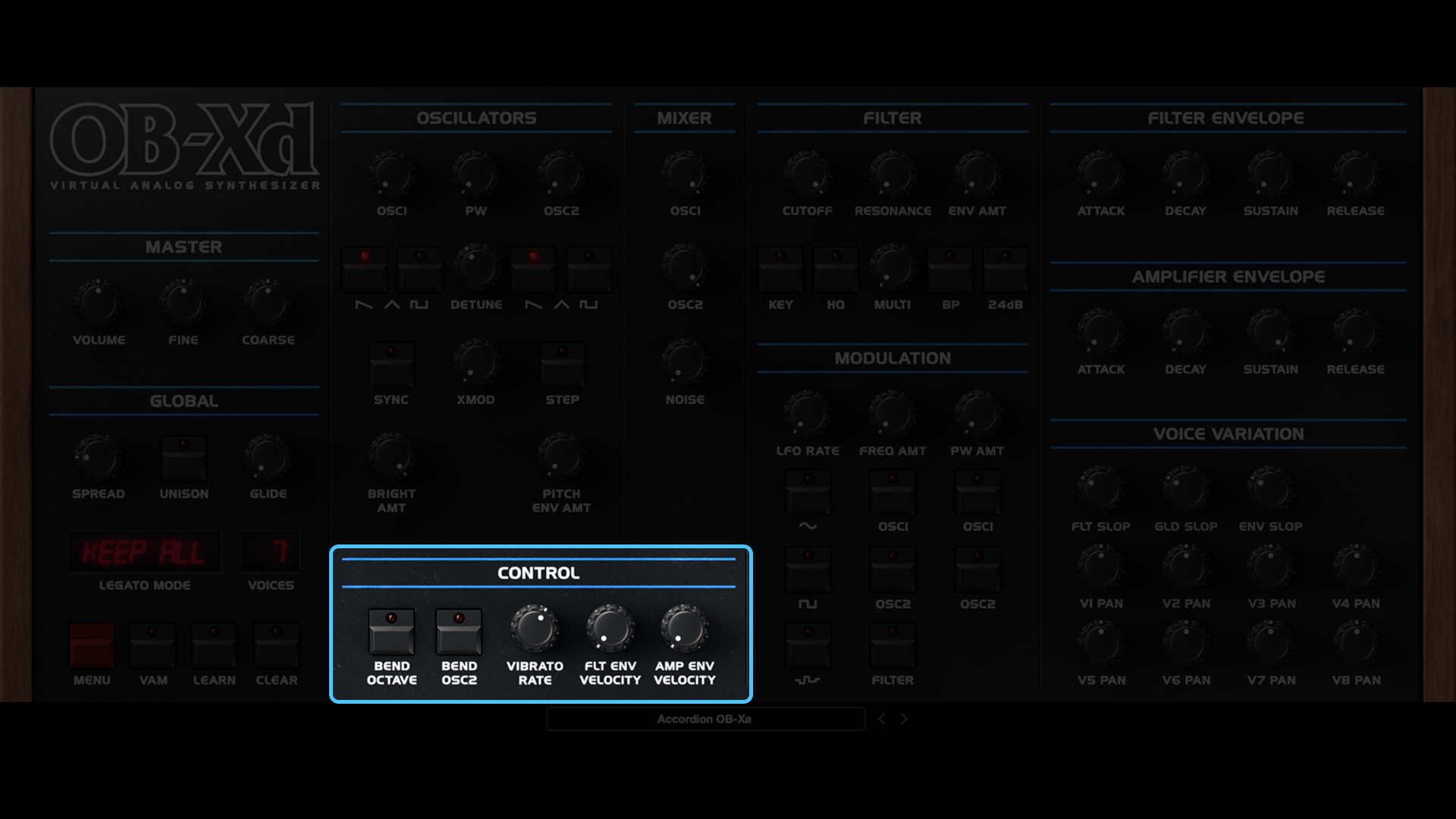
- BEND OCTAVE - Switches the bend from a tone/who-step (default) to an octave
- BEND OSC2 - Applies the pitch bend only to OSC2. This can create some interesting dissonant effects, or better still, when combined with...
- BEND OCTAVE - can create some very cool harmonic ascents/descents (remember the old THX splash-screen?)
- VIBRATO RATE - Speed of modulation-wheel vibrato
- FLT ENV VELOCITY - How much influence note velocity has on the FILTER ENVELOPE. I.e: the harder you play, the brighter (less influential) the FILTER is AMP ENV
- VELOCITY - How much influence note velocity has on the AMP ENVELOPE. I.e: the harder you play, the faster the amplitude attack
Modulation
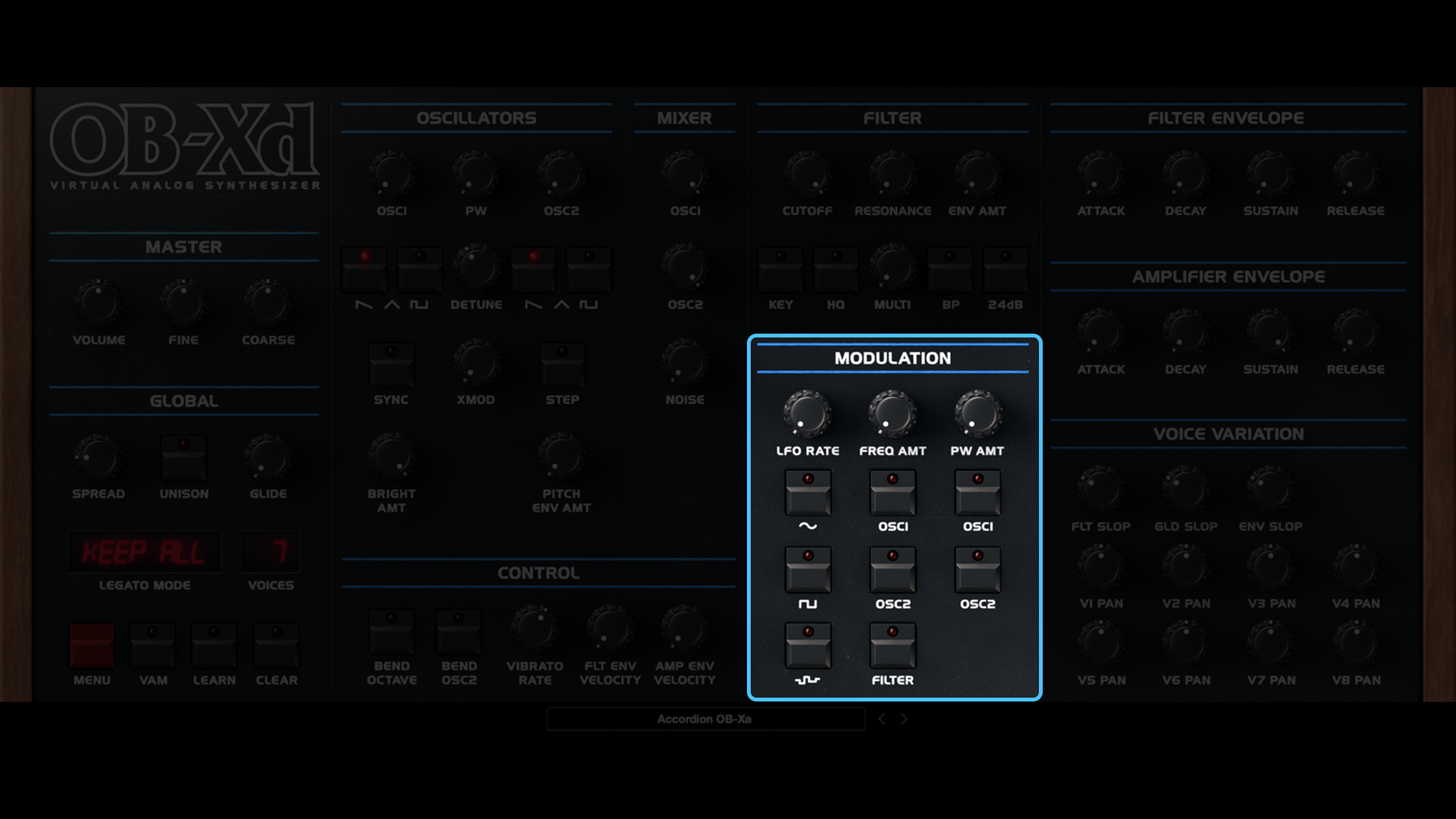
The modulation section allows you to assign LFO modulation to OSC1, OSC2, the FILTER and/or the PW (Pulse Width). The LFO has three shapes (sine, square and random) which can be individually selected, or combined/summed for more modulation variables.
- LFO RATE - LFO speed
- FREQ AMT - LFO depth
- PW AMT - How much the Pulse Width is affected by the LFO (note: this only has an effect on the tone if you’re using pulse/square oscillator tones and have the PW dial in use)
Perhaps, slightly confusingly, the buttons on the right-hand side column of the MODULATION section refer specifically to the pulse width modulation settings.
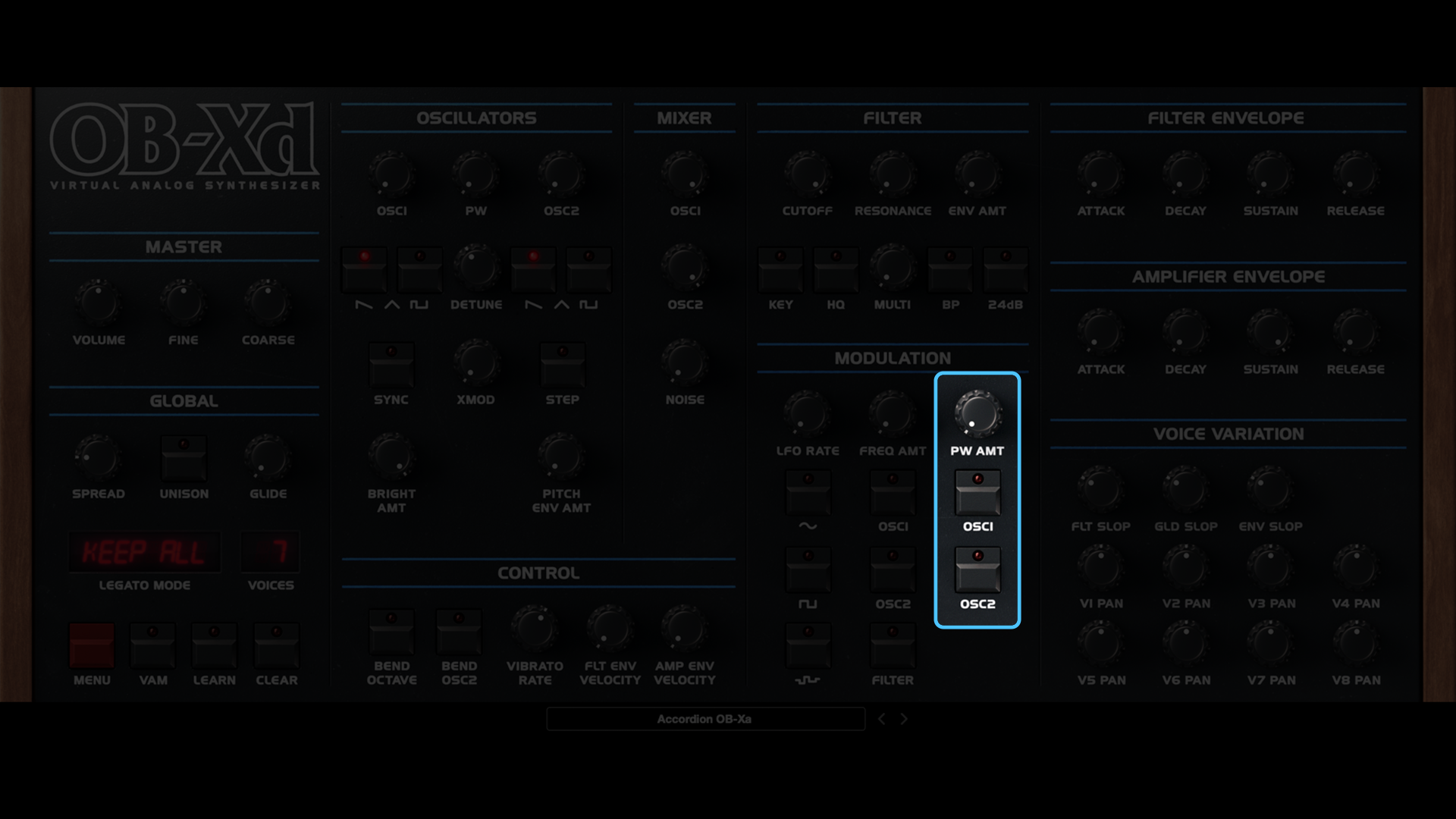
Voice variation
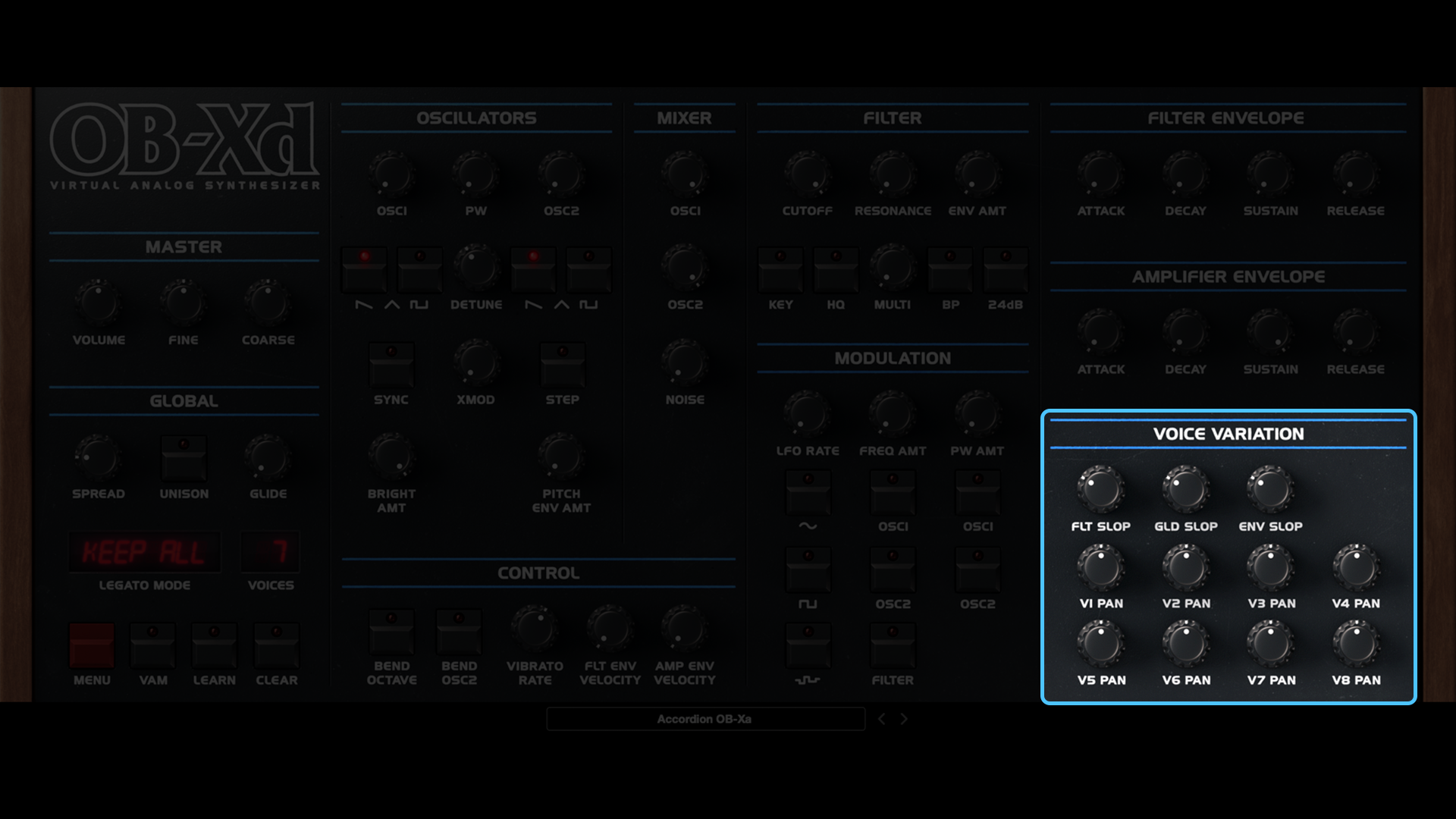
This section is superb for creating really wide tones, as it allows you to individually set the pan settings for voices 1 through 8. This means that you could play an eight-note chord with the notes spread widely across the stereo picture. Not only does this make for an interesting and lively stereo picture, it can be a powerful tool for enhancing stereo chorus and modulation effects.
This feature was quite a novel selling point on the original synthesiser, especially when you consider that polyphonic synthesisers were still fairly new at the time of its release.
The controls are fairly self explanatory; each voice has a corresponding dial (labelled V1 - V8), and they work like any normal pan control (left is left, right is right, centred is equal in both left and right channels).
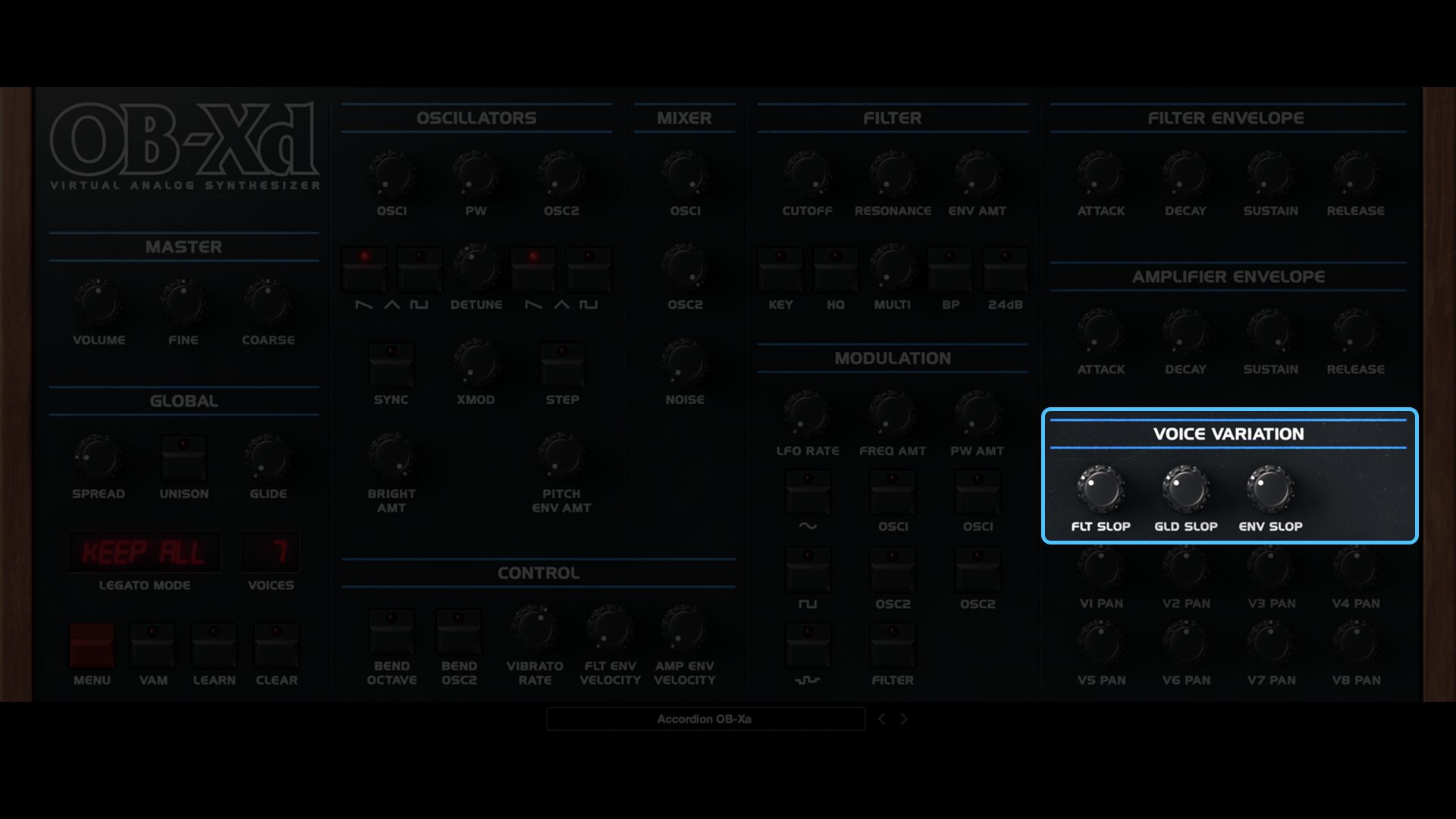
These three dials are unique to this software and not found on the original OB-X. The original OB-X was not velocity sensitive, however the software version does support velocity sensitivity and can therefore incorporate certain functions that go beyond what the original synthesiser could do.
- FLT SLOP (Filter Slope) - How much velocity influences FILTER ENVELOPE depth
- GLD SLOP (Glide Slope) - How much velocity influences the portamento detune amount
- ENV SLOP (Envelope Slope) - How much velocity influences amplifier-envelope depth
Global
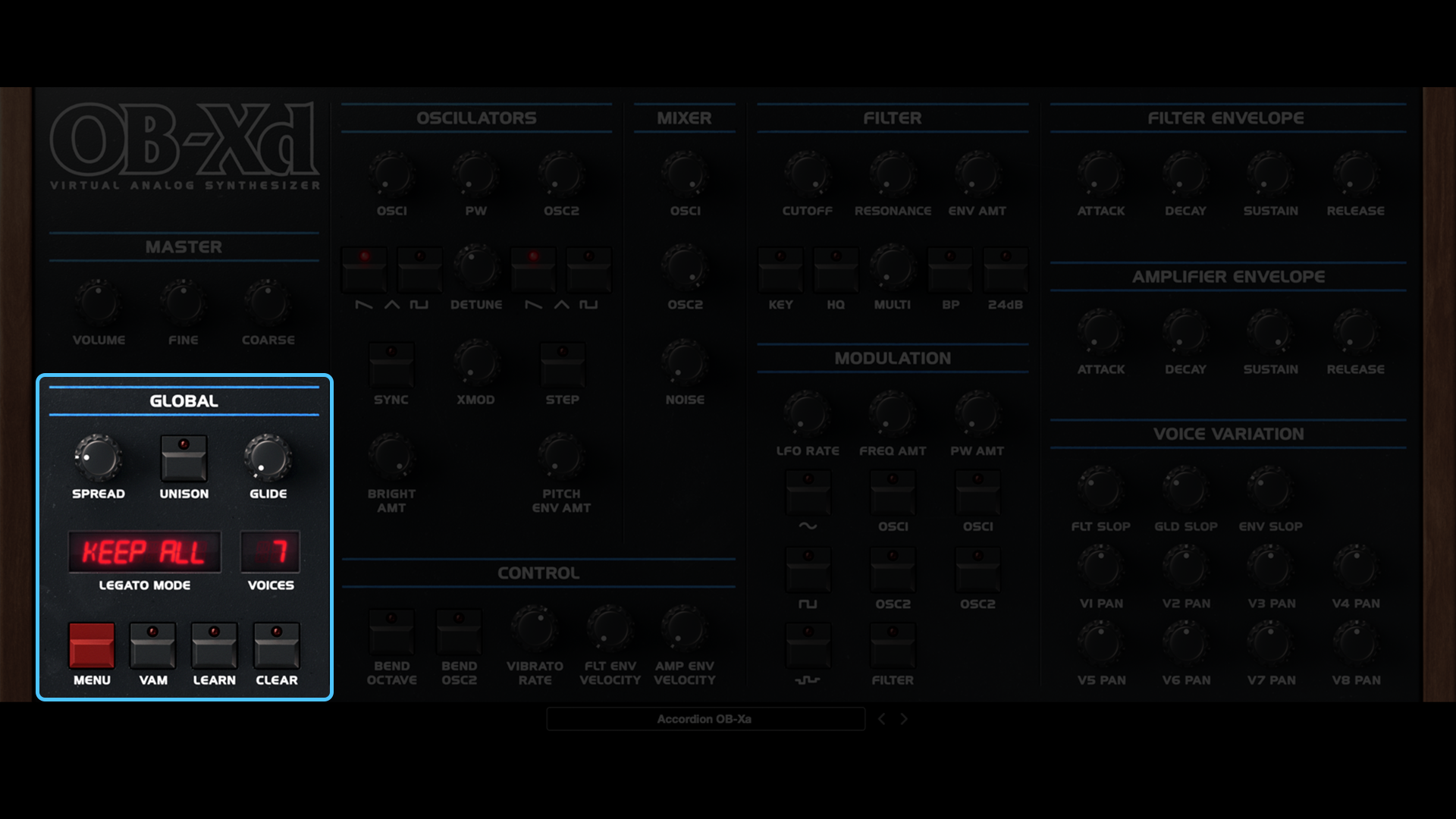
This section aims to bring together some original features with new software features that aim to expand and enhance on the original synth’s capabilities.
- SPREAD - This spreads the tuning variation (think of this as an additional “detune” control)
- UNISON - Stacks all available voices into one note (“spread” and “voice panning” are ineffective when unison is active)
- GLIDE - Sets the portamento time
- VOICES - Number of voices/polyphony
- MENU - Access the synthesiser’s menu, which contains the presets, alternate GUI overlays, other GUI options, preset save features and more
- LEARN - Bind a parameter to a MIDI CC# value for MIDI controller utilisation
- CLEAR - Clears MIDI CC# controller binding
Vam and Legato Mode
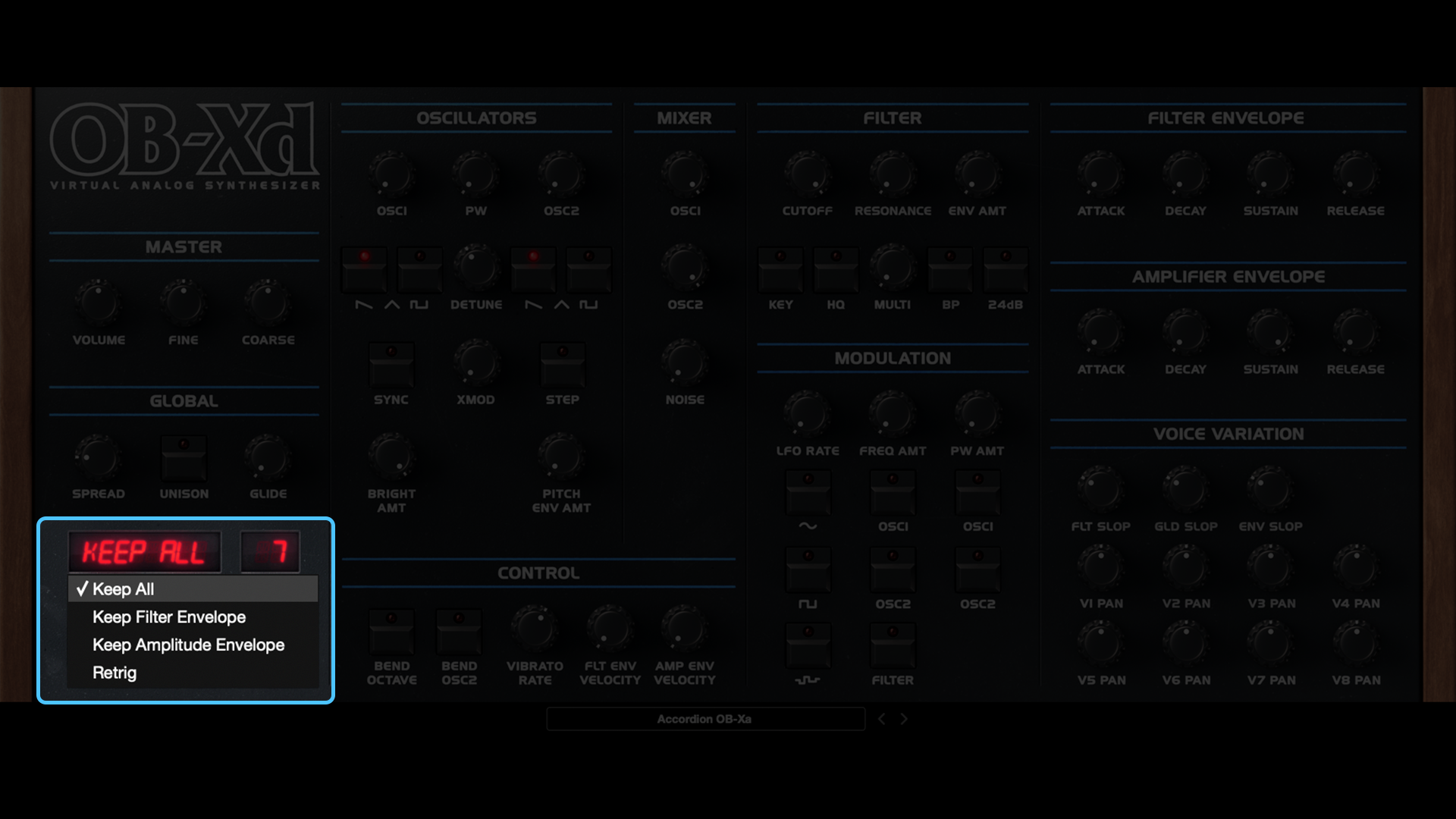
These two features need a little more explanation! Let’s begin with VAM.
The original OB-X was a “low-note” priority synthesiser. I.e. it prioritised the lowest note played if/when the number of notes being played exceeded the number of voices the synthesiser could produce. The OB-Xd is also a “low-note” priority synth by default, however the VAM (Voice Allocation Mode) button switches the note-priority to “last-played” (which is more common on modern synths and will probably feel more intuitive to the average player).
LEGATO MODE concerns how the envelopes behave when multiple notes are played/held which exceed the number of voices available. There are four LEGATO modes as follows:
- Keep All - This mode keeps both the FILTER and AMP envelopes at their respective “sustain” levels
- Keep Filter Envelope - This mode keeps the FILTER ENVELOPE at its “sustain” levels, but allows the AMP ENV to retrigger, cycling through its “attack” and “decay”
- Keep Amplitude Envelope - Keeps held notes at the AMP “sustain” level, but allows the FILTER ENV to retrigger, cycling through its “attack” and “decay”
- Retrigger (“Retrig”) - Retriggers all envelopes
The simplest way to better understand these is to create a 1-voice sound that has a prominent FILTER and AMP ENV (which both contain fairly low “sustain” levels). Once you have a sound designed, play multiple, held notes in each mode; you’ll quickly ascertain precisely what’s happening in each LEGATO MODE.
Master
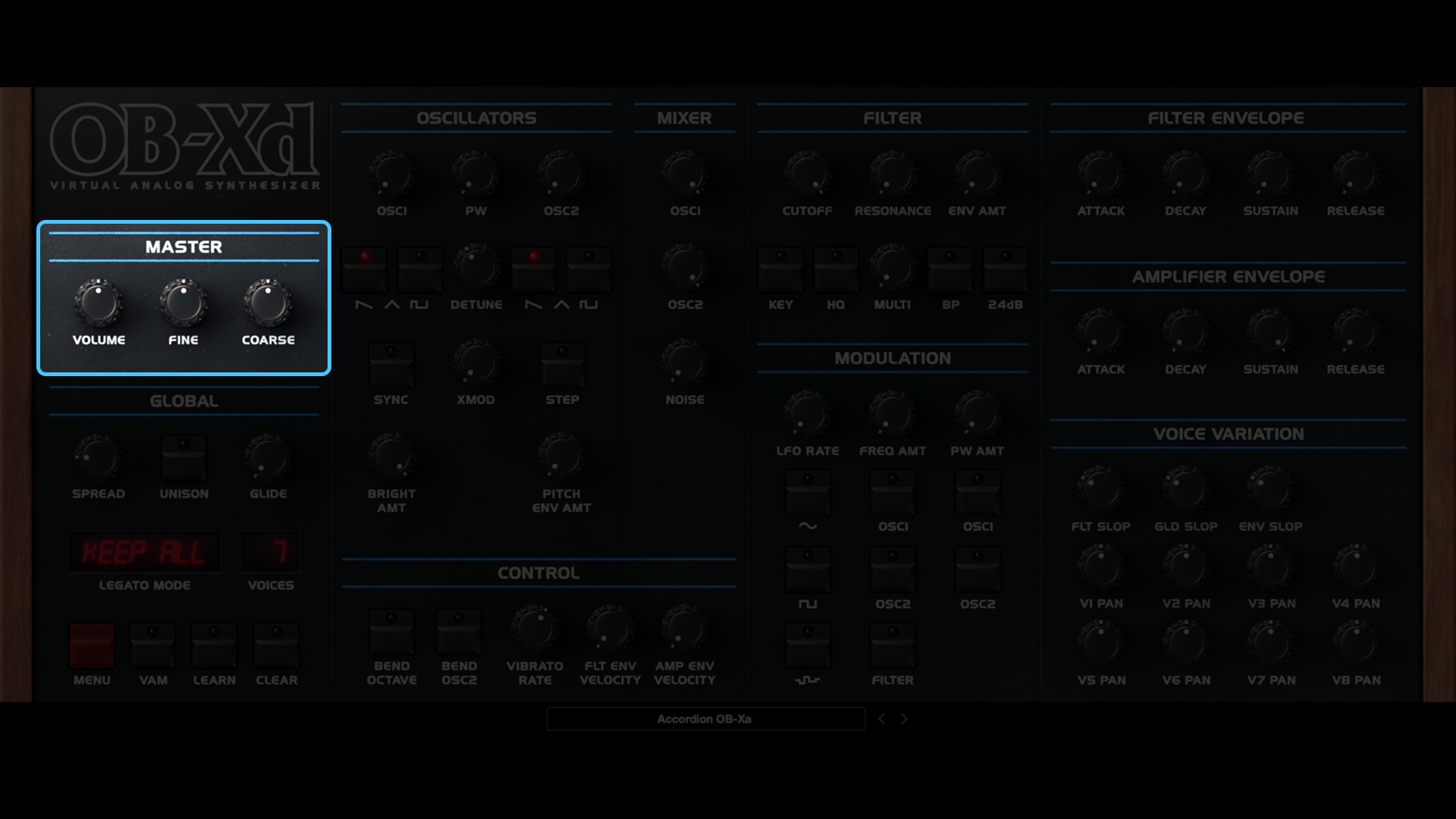
Lastly, we come to the Master section, which is largely self-explanatory. MASTER controls the synth's output volume, while FINE and COARSE enables you to alter the synth's pitch by varying increments.
Let's dive into some presets...
Now that we understand more about the background of this powerful, analogue-modelling synth, and how it works, let’s take a look at some presets and figure out how they're put together.
The OB-Xd already comes with a huge range of very comprehensive and versatile presets, which showcase its sonic capabilities very well. Therefore, rather than design some patches to help explain features (as we did in our previous tutorial), we'll break down and analyse some of the preinstalled presets, which we believe showcase important and/or significant aspects of the OB-Xd (and that sound very cool too, obviously!).
In order to get the most out of the preinstalled presets, we need to understand the Banks, as there are actually way more presets than meets the eye!
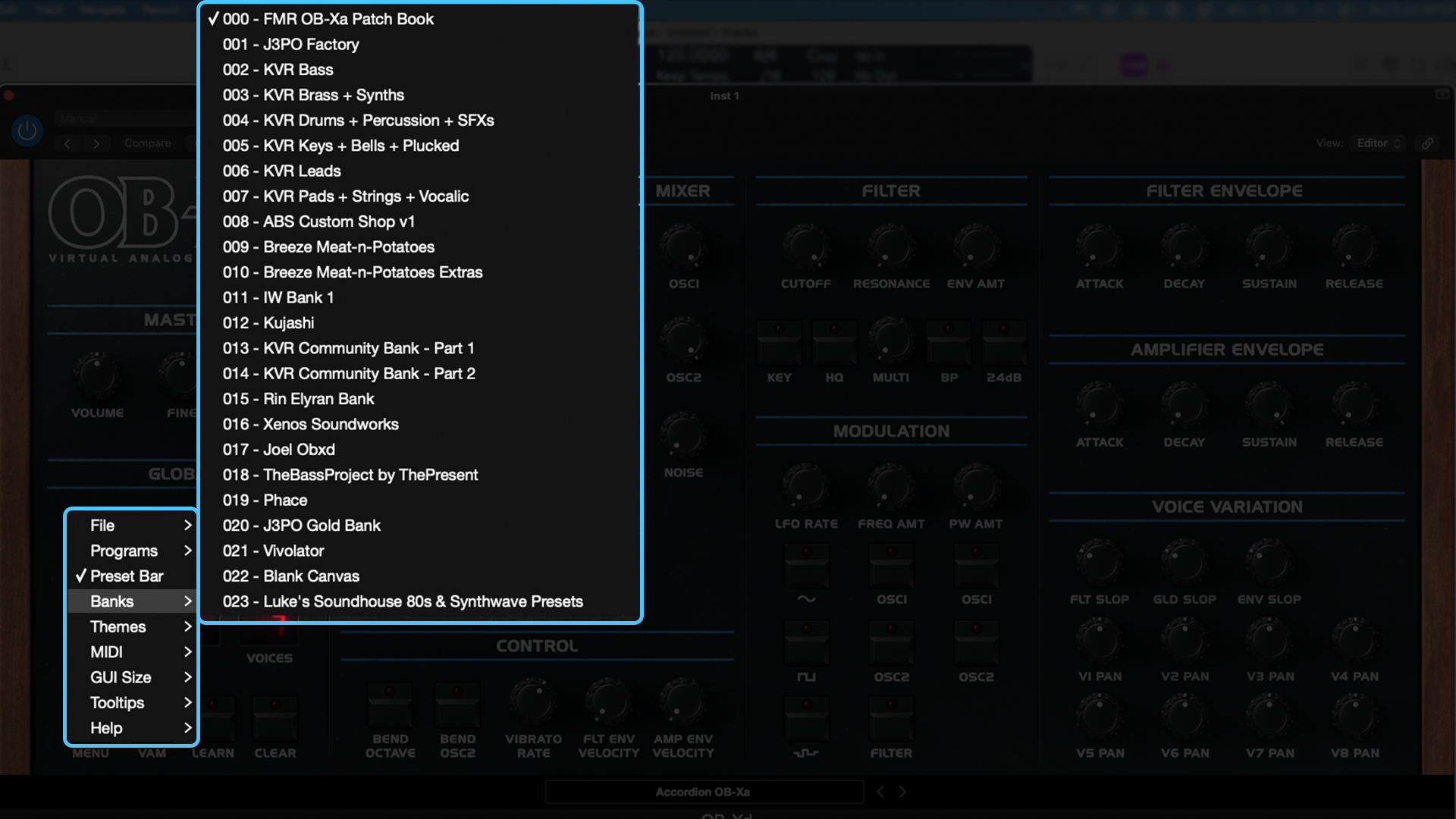
There are 24 Banks, each containing up to 128 presets. Begin by selecting a Bank and then navigating to the preset selection menu in your DAW’s plug-in GUI skin.
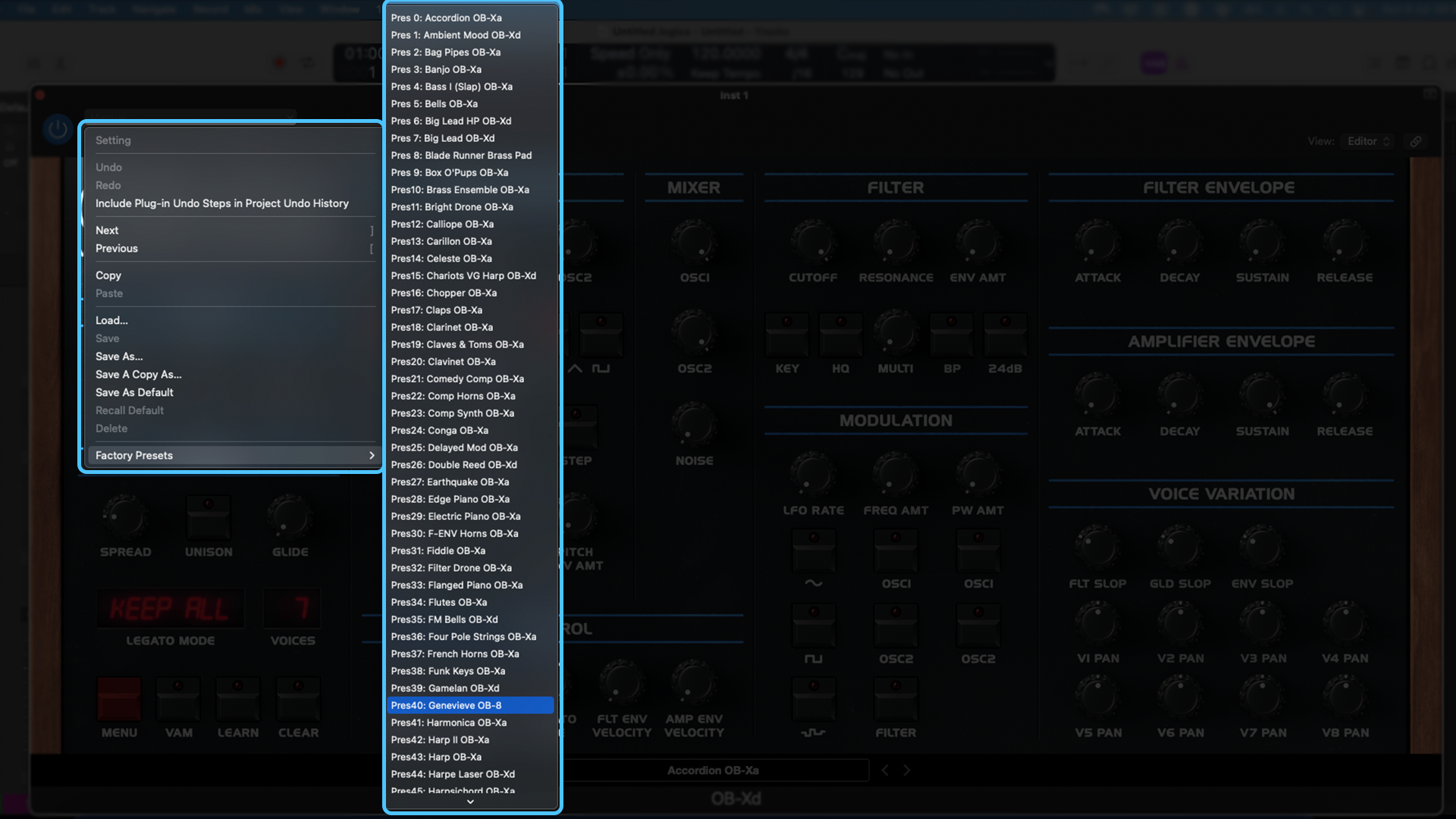
It’s important to note that in the version of Logic Pro we're using for this tutorial (10.7.4) the preset names in the drop-down menu do not update when you change Bank. They always display the preset list for “Bank 000”. This is obviously a glitch. We don’t know if this is unique to Logic Pro, however, if you encounter this issue, as we did, there is a simple work-around.
Whilst the text in the drop-down menu fails to update to the new Bank’s preset list, the presets themselves, and their label at the top of the plug-in exist and work just fine. If you encounter this problem in your DAW, we recommend using the MENU to enable Preset Bar (shown below), as clicking on that shows the correctly listed preset names.
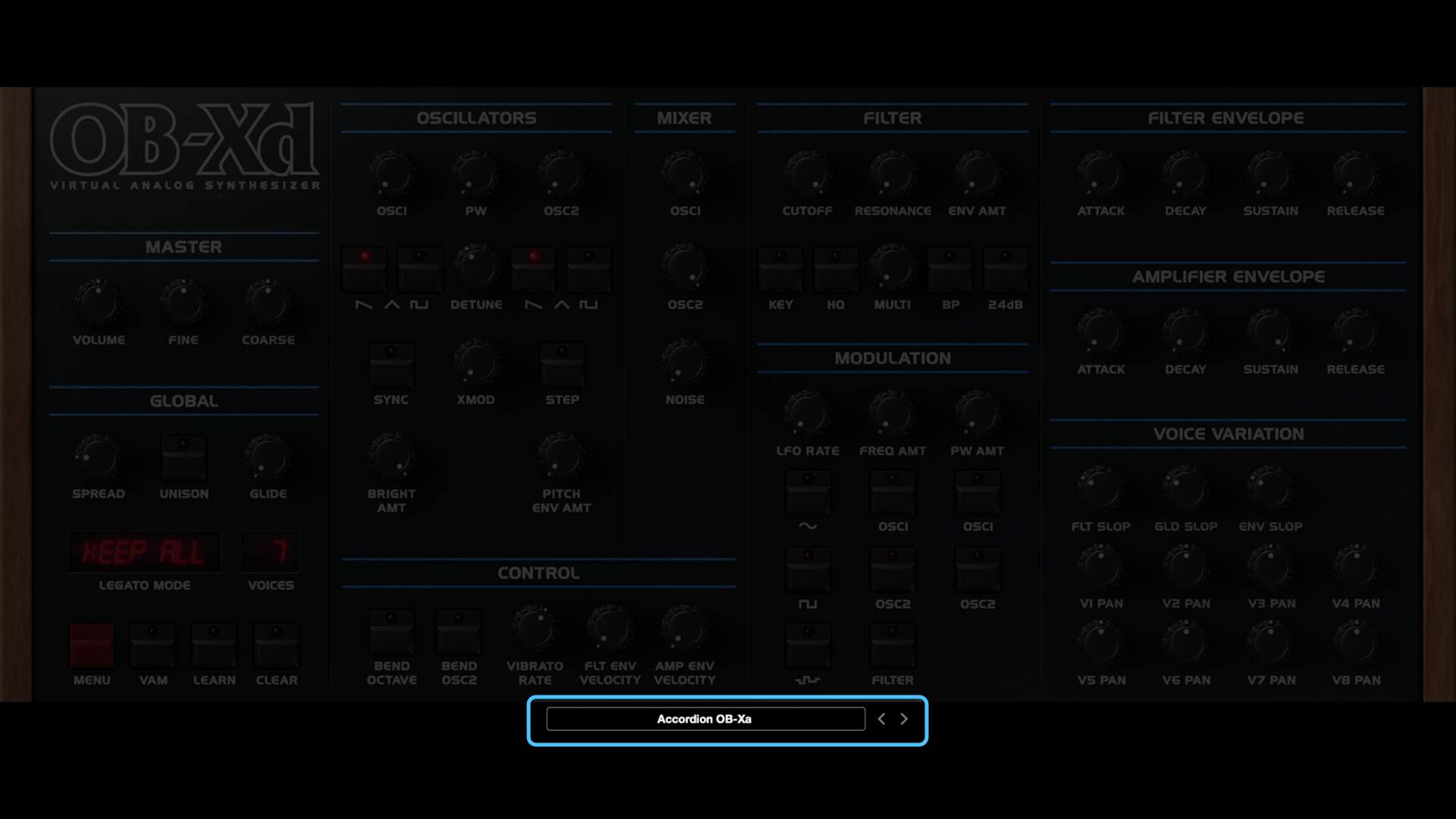
Not every Bank utilises all 128 preset slots, however, there’s more than enough presets there, and their labelling is extremely intuitive, which helps a great deal with patch selection. Now, let’s look at some of my favourites.
Preset 1: Bank 001 - J3PO Factory - Leap
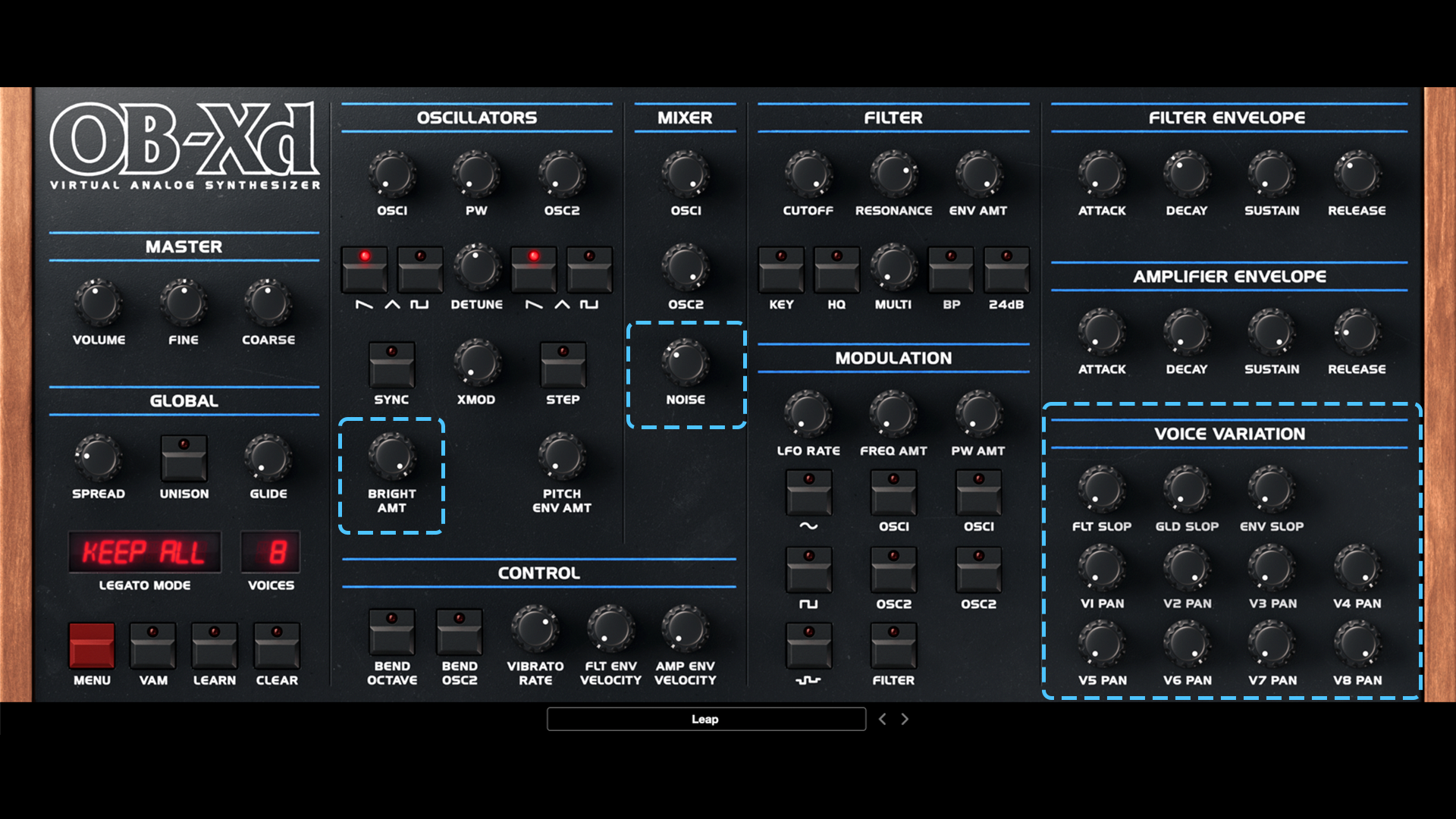
When looking at the OB-Xd, it would frankly be rude not to address the Van Halen shaped elephant in the room! This preset does just that! As you can see from the screenshot, it’s a fairly straight-forward, loud, brash, bright, double saw-tooth patch which is very reminiscent of the synth patch used in Van Halen’s Jump.
Note that the filter is fully open with a little extra resonance for top-end sizzle. The BRIGHT AMT is set to max and there’s a hint of NOISE dialled into the patch as well, all of which contribute to upper-harmonic excitement making this patch a lot of fun and very distinctive.
Furthermore, what we love so much about this patch is the super-wide panning of each voice which provides a fantastic width and openness, leaving bundles of room in the middle of the mix for other parts in your production’s arrangement (e.g. vocals).
Sidenote: for a similar take on this sound, try out the “Dont Jump IW” patch in BANK 011. It is similar in tone, but the tuning feels looser. The stereo image is also narrower, making it more pragmatic for placement within larger arrangements/productions.
Preset 2: Bank 009 - Breeze Meat-n-Potatoes - BzBRS_Silky Brass
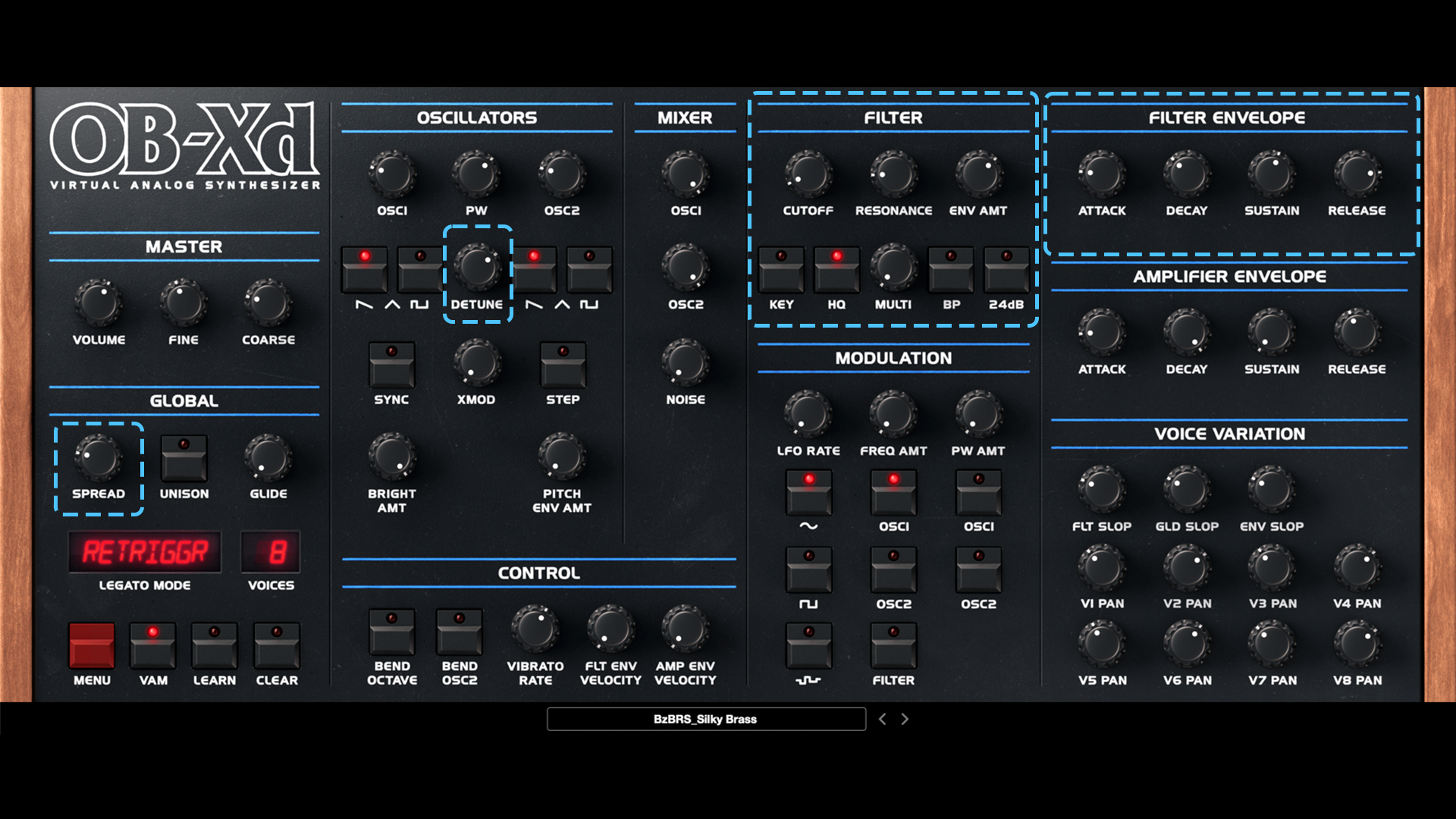
We adore this patch! It’s quite Roland Juno/Jupiter in character, but has a depth and warmth to it that only the OB-X can capture. On the surface, it appears to be a simple two-sawtooth oscillator, but what really makes this patch shine is the FILTER and its ENVELOPE.
There’s a very quick movement to the FILTER ENVELOPE upon note-trigger that (with the aid of a little resonance) really demonstrates the warm character of the OB-Xd’s filter (notably the HQ button is enabled for this preset).
Also note there’s a reasonable amount of SPREAD, DETUNE and subtle use of voice panning, culminating in a wide, all encompassing sound, that has both gloss in the top-end, and real oomph down low.
Preset 3: Bank 002 - KVR Bass - BASS - BrASS Lead FB
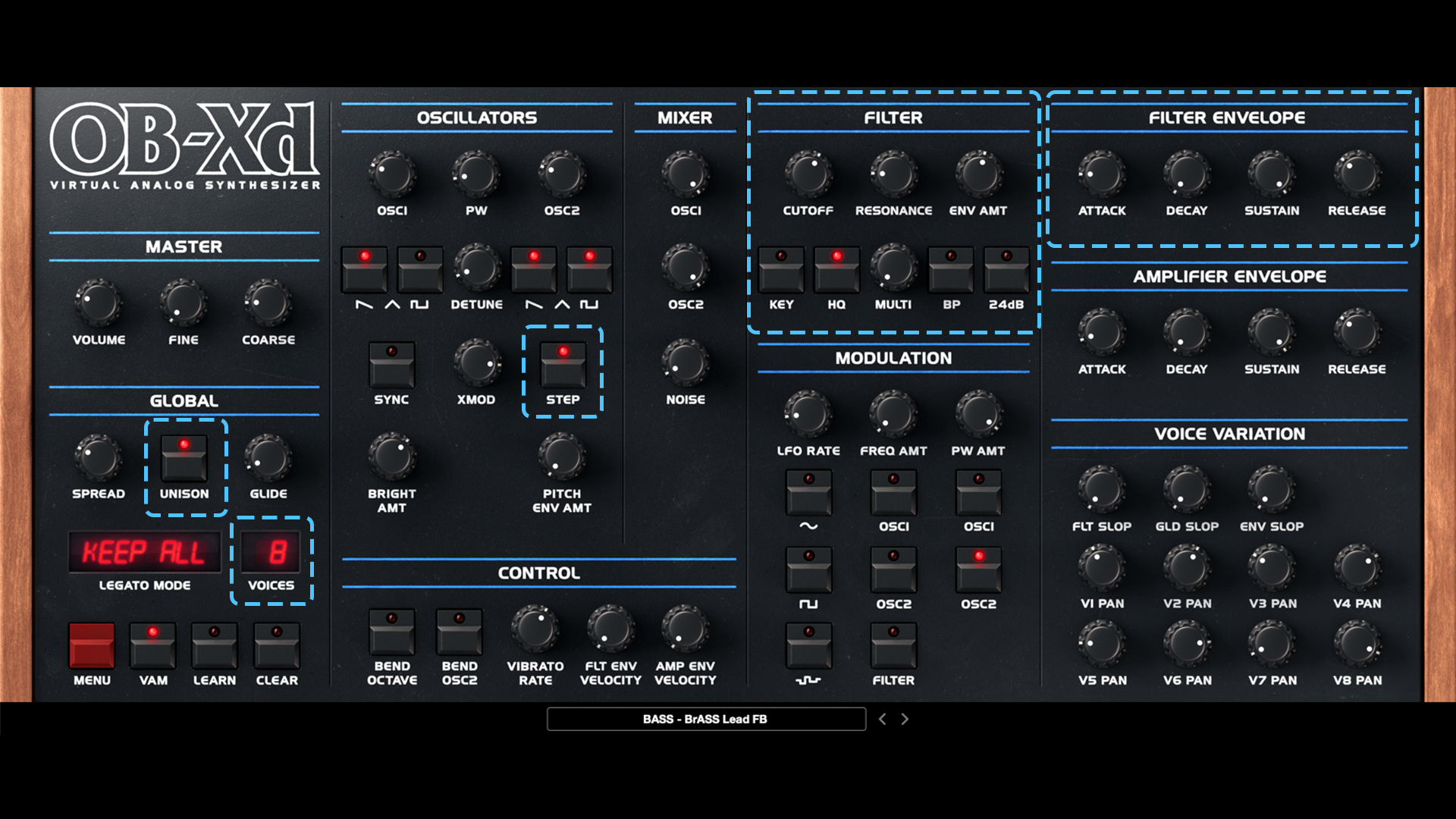
This patch is monstrously beefy and simply awesome! It’s got some real punch to it and is great for both lead lines and bass lines. Some of its tonal power can be credited to the OSCs and FILTER, but we think its real strength comes from two places.
Firstly, the use of STEP aligns the tuning of the OSCs without syncing them (which keeps them a little wider and chorus-like in tone). Secondly loading up 8 un-synced voices in UNISON really brings weight and body to this tone.
It’s quite a simple premise, but sometimes, less is more, and in this instance, the simplicity of the stacked, unsynced voices provides an end result that absolutely slaps.
Preset 4: Bank 023 - Luke’s Soundhouse 80s & Synthwave Presets - 99 Pad
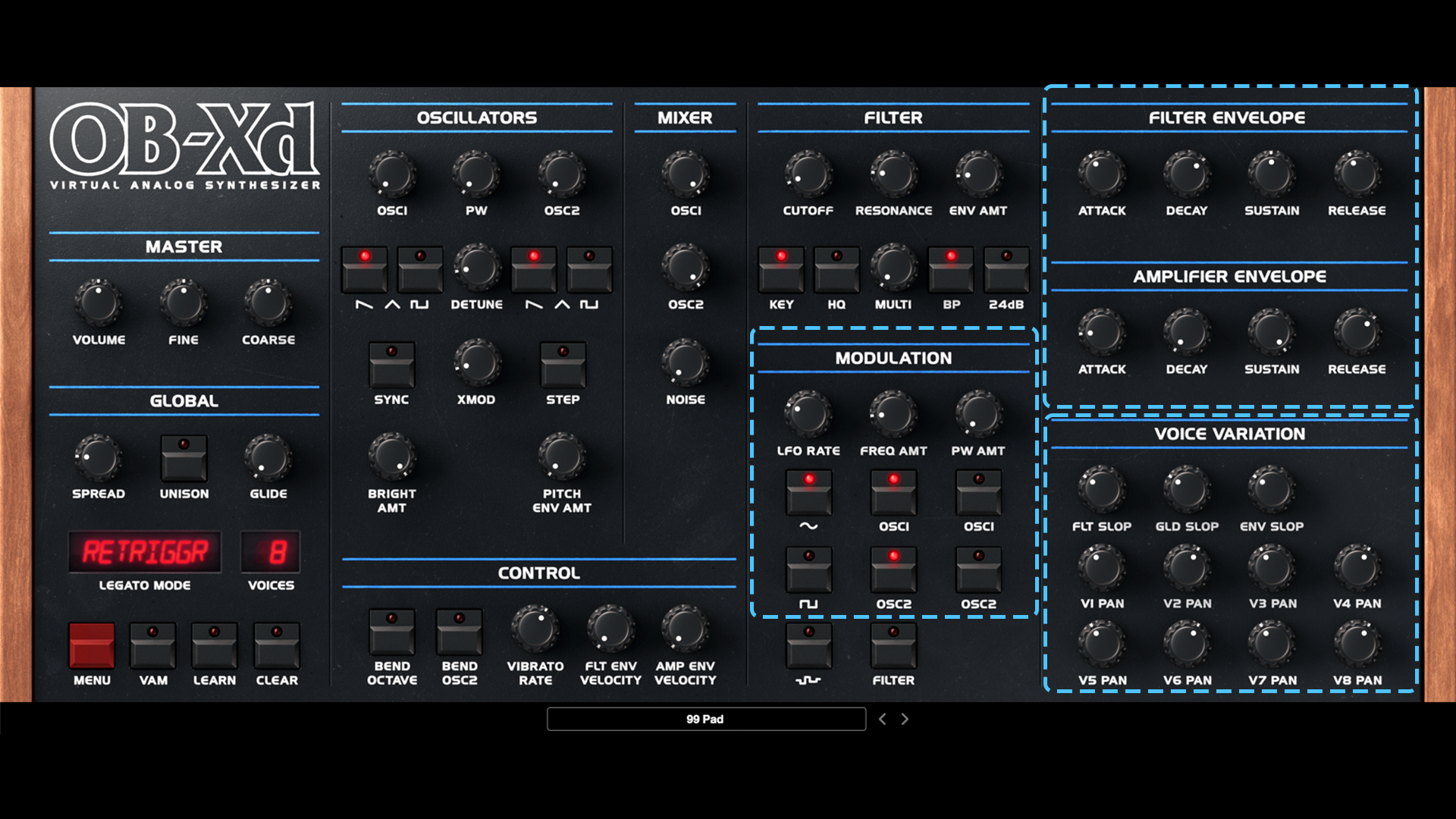
This patch wobbles and moves mournfully on the edge of discomfort, as the LFO modulates the pitch of the OSCs (which themselves are subtly cross-modulating). Add to this subtle voice panning, slow enveloping of both FILTER and AMPLIFIER and the end result is a gorgeous, wide tone, steeped in melancholic sentimentality.
It’s also a great starting point for shaping your own pads. Try reducing the LFO RATE and FREQ AMT ever so slightly, and raising the CUTOFF by about 10 degrees. We find these changes retain the character of the original preset, but change the melancholy character into one of hopefulness (with the increased tuning stability and slight brightening).
Preset 5: Bank 021 - Vivolator - Tile Drop
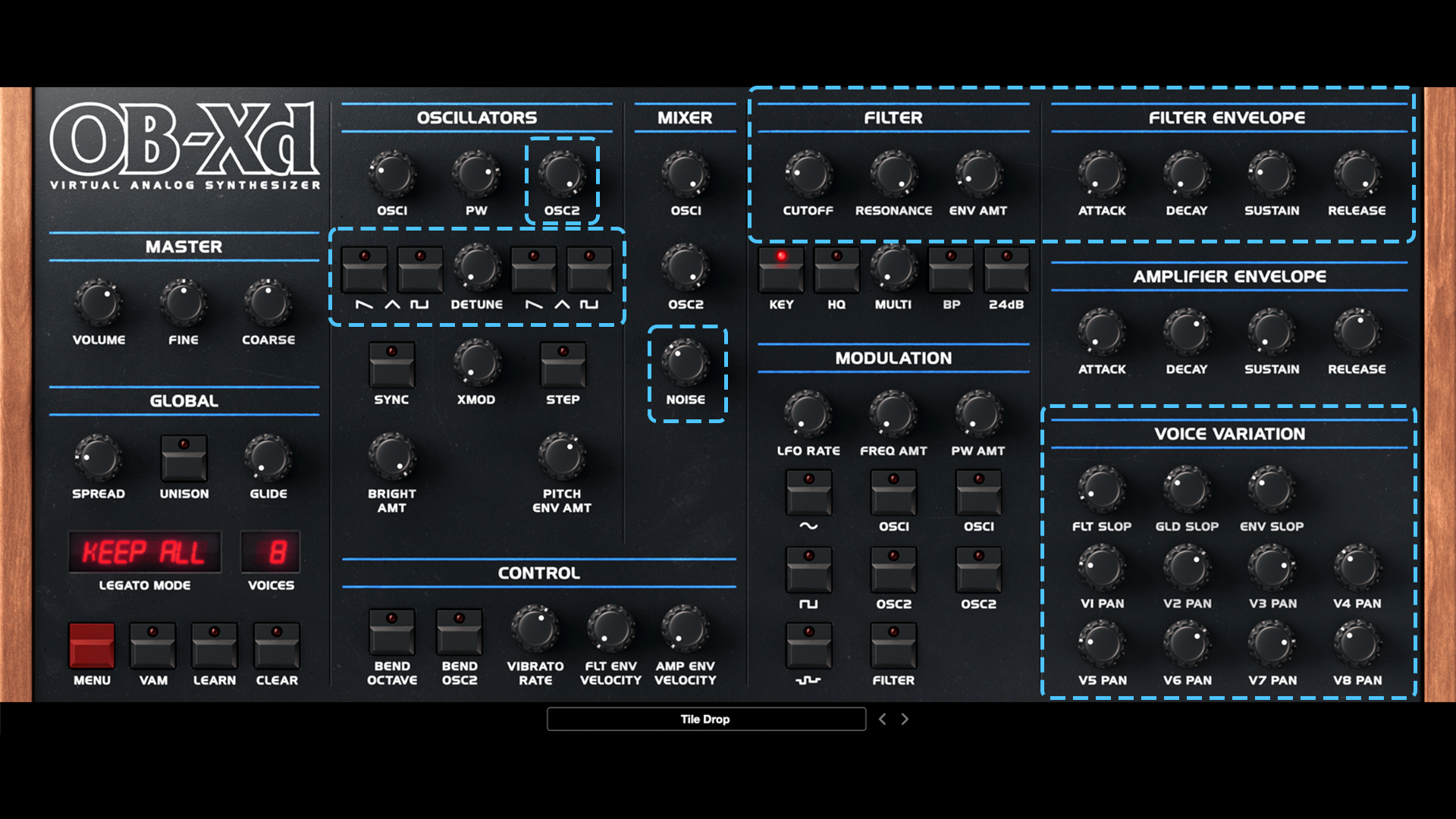
Something that subtractive synths are not well known for is metallic and bell-like sounds (something FM synthesis of the mid/late 80s would capitalise on). However, due to the numerous ways in which the OB-X could manipulate tuning (and the cross modulation between OSC), it could sometimes produce some respectable metallic and glassy tones.
What draws us to this preset is that it utilises triangle-wave OSCs and a meaningful amount of noise in its bell-like/chime-tone creation. The way the FILTER is ENVELOPED (with maximum RESONANCE) somewhat mimics the tonal behaviour of striking a metallic chime with a mallet.
Furthermore, the addition of noise to the tone creates a sort of pseudo-reverb illusion, adding air and spatial depth to the tone (aided by the voice panning); a sonic-characteristic that reminds us of early electronic ambient music.
Conclusion
We were fortunate enough to briefly play an OB-X a few years ago, and were taken by its character and majesty. It’s an instrument that speaks with grandeur and confidently wears its quirks and nuances with pride. Whilst it’s built on established, commonplace principles, it manages to have numerous distinctive and defining characteristics which stand it apart from other synths of the era.
We're of the opinion that it’s one of the most interesting and accessible synthesisers ever created, walking a line of simple, ergonomic design atop of surprising versatility and tonal complexity.
We're also of the opinion that the OB-Xd unquestionably does a fantastic job of recreating the soul and character of this instrument, whilst also modernising it in gentle, unintrusive ways, that serve the musical potential of the instrument, without compromising authenticity.
Whether you’re new to synthesis or a seasoned synthesiser veteran, we strongly recommend (insist, even!) that you download this synth and have a play with it. We're certain you’ll enjoy exploring all it has to offer. And if you happen to end up using the OB-Xd in the creation of music from which you draw an income, we ask that you do the honourable thing, and respect DiscoDSP’s honesty policy; pay the $49 asking price, because all things considered, it’s a hell of a lot of synthesiser for the money - especially as you can use it to your heart’s content before deciding whether or not to buy it.


“OSC” Steve is a composer, producer and educator with a background in piano, synthesisers and sound-engineering. He is an established, independent artist in the Synthwave and Retrowave music scenes, and has composed for several independent video-games including Nintendo Switch™ titles.
